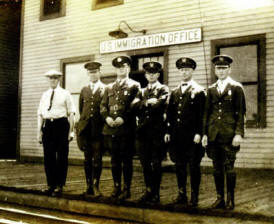|
Immigration and Naturalization Service

The United States Immigration and Naturalization Service
(INS) was a part of the United States Department of
Justice and handled legal and illegal immigration and
naturalization. It ceased to exist on March 1, 2003.
Most of its functions were transferred to three new
agencies within the newly created Department of Homeland
Security in March 2003. The administration of
immigration services, including permanent residence,
naturalization, asylum, and other functions became the
responsibility of the Bureau of Citizenship and
Immigration Services (BCIS), which existed only for a
short time before changing to its current name, U.S.
Citizenship and Immigration Services (USCIS). The
investigative and enforcement functions (including
investigations, deportation, and intelligence) were
combined with U.S. Customs investigators, the Federal
Protective Service, and the Federal Air Marshal Service,
to create U.S. Immigration and Customs Enforcement
(ICE). The border functions of the INS, which included
the Border Patrol along with INS Inspectors, were
combined with U.S. Customs Inspectors into the newly
created U.S. Customs and Border Protection (CBP).
Mission
INS protected and enforced the laws of naturalization,
the process by which a foreign-born person becomes a
citizen. The INS also tackled illegal entrance into the
United States, preventing receipt of benefits such as
social security or unemployment by those ineligible to
receive them, and investigated, detained, and deported
those illegally living in the United States.
Structure
At the head of the INS was a commissioner appointed by
the president who reported to the Attorney General in
the Department of Justice. The INS worked closely with
the United Nations, the Department of State, and the
Department of Health and Human Services. The INS was a
very large and complex organization that had four main
divisions—Programs, Field Operations, Policy and
Planning, and Management—that were responsible for
operations and management.
The operational functions of the INS included the
Programs and Field Operations divisions. The Programs
division was responsible for handling all the functions
involved with enforcement and examinations, including
the arrest, detaining, and deportation of illegal
immigrants as well as controlling illegal and legal
entry. |
|
|
The Field Operations division was responsible
for overseeing INS' many offices operating
throughout the country and the world. The Field
Operations division implemented policies and
handled tasks for its three regional offices,
which in turn oversaw 33 districts and 21 border
areas throughout the country. Internationally,
the Field Operations division oversaw the
Headquarters Office of International Affairs
which in turn oversaw 16 offices outside the
country.
Managerial functions of the INS included the
Policy and Planning and Management divisions.
The Office of Policy and Planning coordinated
all information for the INS and communicated
with other cooperating government agencies and
the public. The office is divided into three
areas: the Policy Division; the Planning
Division; and the Evaluation and Research
Center. The second managerial division, called
the Management division, was responsible for
maintaining the overall mission of the INS
throughout its many offices and providing
administrative services to these offices. These
duties were handled by the offices of
Information Resources Management, Finance, Human
Resources and Administration, and Equal
Employment Opportunity.
History
Shortly after the U.S. Civil War, some states
started to pass their own immigration laws,
which prompted the U.S. Supreme Court to rule in
1875 that immigration was a federal
responsibility. The Immigration Act of 1891
established an Office of the Superintendent of
Immigration within the Treasury Department. This
office was responsible for admitting, rejecting,
and processing all immigrants seeking admission
to the United States and for implementing
national immigration policy. 'Immigrant
Inspectors', as they were called then, were
stationed at major U.S. ports of entry
collecting manifests of arriving passengers. Its
largest station was located on Ellis Island in
New York harbor. Among other things, a 'head
tax' of fifty cents was collected on each
immigrant.
Paralleling some current immigration concerns,
in the early 1900s Congress's primary interest
in immigration was to protect American workers
and wages: the reason it had become a federal
concern in the first place. This made
immigration more a matter of commerce than
revenue. In 1903, Congress transferred the
Bureau of Immigration to the newly created
(now-defunct) Department of Commerce and Labor.
After World War I, Congress attempted to stem
the flow of immigrants, still mainly coming from
Europe, by passing a law in 1921 and the
Immigration Act of 1924 limiting the number of
newcomers by assigning a quota to each
nationality based upon its representation in
previous U.S. Census figures. Each year, the
U.S. State Department issued a limited number of
visas; only those immigrants who could present
valid visas were permitted entry.
President Franklin Roosevelt moved the INS from
the Department of Labor to the Department of
Justice in 1940.
In November 1979, Attorney General Benjamin
Civiletti announced that INS raids would only
take place at places of work, not at residences
where illegal immigrants were suspected to live. |
|
|
























